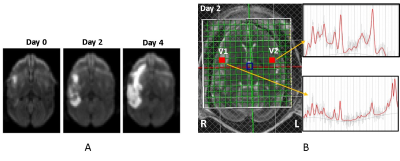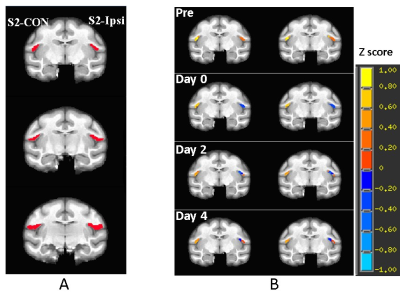Chun-Xia Li1, Frank Tong2, Doty Kempf1, Leonard Howell1, and Xiaodong Zhang1
1Yerkes Imaging Center, Yerkes National Primate Research Center, Emory University, Atlanta, GA, United States, 2Department of Radiology, Emory University, Atlanta, GA, United States
1Yerkes Imaging Center, Yerkes National Primate Research Center, Emory University, Atlanta, GA, United States, 2Department of Radiology, Emory University, Atlanta, GA, United States
Previous studies have
suggested cerebral
Choline (Cho) is a sensitive marker of acute stroke and
could protect the tissue from ischemic injury. Also the relative connectivity (RelCon) could be a
robust index to reveal the functional connectivity
changes using resting state fMRI
(rs-fMRI). The results indicated progressively increased
RelCon in
secondary somatosensory cortex (RelCon-S2)
and a significant positive correlation between RelCon-S2 and relative cerebral
Choline level (RelCho) from hyper-acute phase to 96 hours post stroke. The
RelCon and RelCho combined detection might be an optimized and promising approach in management and prediction
of stroke recovery.

Figure 1. A) The diffusion-weighted images of a
stroke monkey brain demonstrated infarct
evolution on Day 0, 2, and 4 post
stroke (left). B) in vivo proton MR
spectra in the contralateral and ipsilateral voxels in the stroke monkey brain
2 days post stroke. V1, MR Spectrum of
contralateral voxel; V2, MR spectrum of ipsilateral area after MCA occlusion.

Figure 2. A) Illustration of the representative
slices of a stroke monkey brain with regions of interest of contralateral
secondary somatosensory cortex (S2)(S2-CON, seed for functional
connectivity analysis)
and the ipsilateral S2 (S2-Ipsi). B) representative correlation map of
S2 in a stroke monkey brain before stroke surgery
(Pre) and post surgery. p = 0.026 with 20 voxels as threshold.